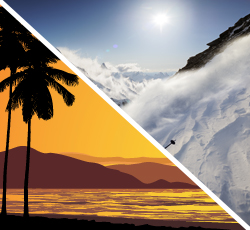In Part 1 of the Temperature Training blog we covered the difference between relative race temperature (RRT) and absolute race temperature plus tips on how to train for a warm weather OCR when you live in a cold environment. This blog will focus on the opposite, training in warm weather for a race that will take place in a cold climate.
Training in the Heat for a Cold Weather Race
This is the harder of the two scenarios, quite simply because you can't just keep taking off layers until you get colder. The philosophy of temperature control and adjustment is the same as before, but in reverse. In this case your body will get used to NOT producing heat during strenuous exercise, which is precisely what you want it to do during your cold race. While the strategy in Part 1 focused on things TO DO, much of this is based on what NOT to do.
You want to avoid training in the heat whenever possible, which means structuring your outdoor training in the evenings or even overnight when it is the coolest, and particularly avoiding those really hot days. In the prior blog (Temperature Training - Part 1) I told you to start your cold weather runs in an already warmed state, because even the brief period of feeling cold will have a lasting impact, running in severe heat on just a few occasions will negate a lot of this preparation. If you must train when the weather is very hot, focus on strength workouts as opposed to cardio on the days where temperatures are at their highest.
If you are fortunate enough to live near a body of water that is a great way to limit your body's exposure to heat. Water transfers heat 25 times faster than air, and since most water is significantly less than the 98.6 degrees your body operates at, 75 degree water feels like a much cooler environment than 75 degree air. Again this is about tricking your body's perception of temperature and how it responds. Aside from swimming, you can get very creative about water exercise including running sprint intervals, rock carries, and building dams! Even consistently dunking yourself can be an effective tool.
Not everyone has easy access to a body of water. What you can do is follow every workout with an ice cold shower. This will shock your muscles and get them used to the restrictive tight feeling that comes in severe cold. If you want to really up the ante, forego warm showers entirely for a month or two leading up to the race. I did this before World's Toughest Mudder (WTM) and after a few weeks I really became accustomed to quickly being immersed in the cold. The caveat here is if you are dealing with any small muscle pulls or injuries, you may want to take a break from the cold showers until the injury subsides. I also found that post workout stretching became much more important if I was taking a freezing shower.
Ultimately the race environment is going to be a shock to your temperature balance. There is just no way to completely mitigate the impact of a 70 or 80 degree temperature variance between 3-6 months of training and spending a day or two at the race location. These techniques can certainly lessen that variance, and give you the experience of feeling a rush of extreme heat or cold that will undoubtedly hit you at a surprise moment during a race. And if you have seen that before, and perhaps it knocked you out of commission once or twice during training, at least now you can recognize it sooner, adapt or avoid it, and give yourself the best chance at a strong finish. I personally love the temperature battle, it is just one more in a long list of obstacles that contribute to the uniqueness of this sport, and the many ways it pushes and challenges you past your comfort zone!
Share your temperature training tips in the comments section below.
This article and/or product are not intended to provide medical advice, diagnosis or treatment. Consult a medical doctor prior to training for or participating in any Obstacle Course Race.
 This is a guest post by Brian Lynch. Brian works in Wealth Management at UBS in Boston MA and has been involved in OCR since 2011. Recreation quickly turned to passion and then to obsession, and Brian now focuses his training on Ultra Distance OCR. Brian is a 2 time Worlds Toughest Mudder participant (finishing and completing 50 miles in 2012), a 2 time Spartan Ultra Beast finisher, and one of the 40 inaugural Fuego Y Agua Survival Run competitors. Brian's training focuses on body weight exercises for functional strength, high intensity circuit training for cardio and agility, and long distance trail running for endurance.
This is a guest post by Brian Lynch. Brian works in Wealth Management at UBS in Boston MA and has been involved in OCR since 2011. Recreation quickly turned to passion and then to obsession, and Brian now focuses his training on Ultra Distance OCR. Brian is a 2 time Worlds Toughest Mudder participant (finishing and completing 50 miles in 2012), a 2 time Spartan Ultra Beast finisher, and one of the 40 inaugural Fuego Y Agua Survival Run competitors. Brian's training focuses on body weight exercises for functional strength, high intensity circuit training for cardio and agility, and long distance trail running for endurance.







